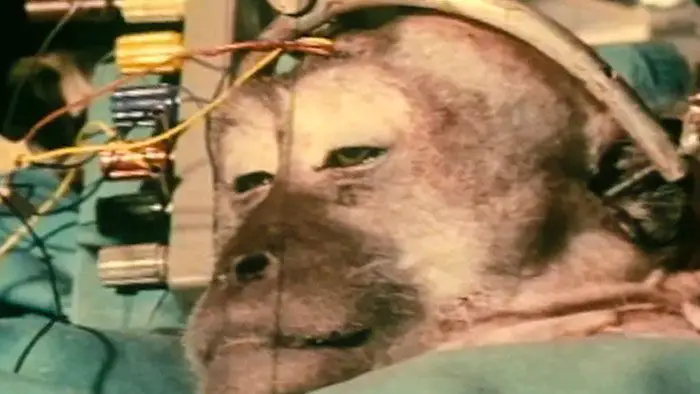 octor White is still remembered as the pioneer of modern neurosurgery and this is because of his tremendous contributions to the field of neuroanesthesia and bioethics. He was schooled in the medical field at the University of Minnesota and after working in many different hospitals ended up doing research at Harvard University in the medical and scientific department. What makes him very famous in the medical field is that Doctor White was the first neurosurgeon to perform a successful cephalic exchange on monkeys, in other words, the first neurosurgeon to perform a successful head transplant on monkeys.
octor White is still remembered as the pioneer of modern neurosurgery and this is because of his tremendous contributions to the field of neuroanesthesia and bioethics. He was schooled in the medical field at the University of Minnesota and after working in many different hospitals ended up doing research at Harvard University in the medical and scientific department. What makes him very famous in the medical field is that Doctor White was the first neurosurgeon to perform a successful cephalic exchange on monkeys, in other words, the first neurosurgeon to perform a successful head transplant on monkeys.
Going for the impossible
This wise man had a great saying that he always went by, not only in his life but in his field of studies. He was always mentioning that just because something seems impossible today that does not mean it can’t happen tomorrow. Before his successful head transplant, Doctor White tried numerous times the same operation on Monkeys. Why monkeys you may ask, well monkeys are the closest relative to the human organism as well as structure. All the research and work that he has done was with the hope of one day managing a head transplant on human beings.
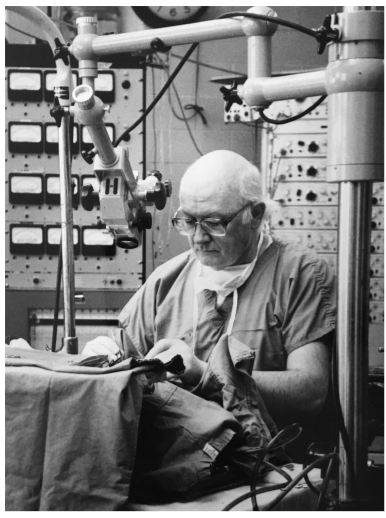
Even so, knowing that the human organism is much more complex, therefore, there are a lot more complications to take into account, this surgery was a tremendous leap not only for modern neurosurgery but also in the medical field. The main problem that Doctor White had during all of his attempts was that the brain of the donor monkey would suffer permanent Damage until it would be placed onto the new body. The second problem was the difficulty to reconnect the carotid and jugular vessels between the donor and recipient primate. those are the vessels that contain all the nerve highways as well as the jugular taking blood to the head.
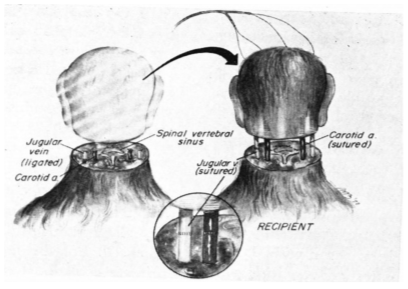
After many attempts, Doctor White has discovered that if you lower the temperature of the brain below 15 degrees Celsius then it will be protected against otherwise fatal ischemia. However, even so, the brain still ended up damaged whilst the head from the original body was severed. This was because the donor’s brain was not receiving sufficient oxygen. This meant that there was a need for a new system that will offer a regular blood flow as well as enough oxygen for the brain to not get damaged up to the point of the transplant. So Doctor White got to work and came up with this.
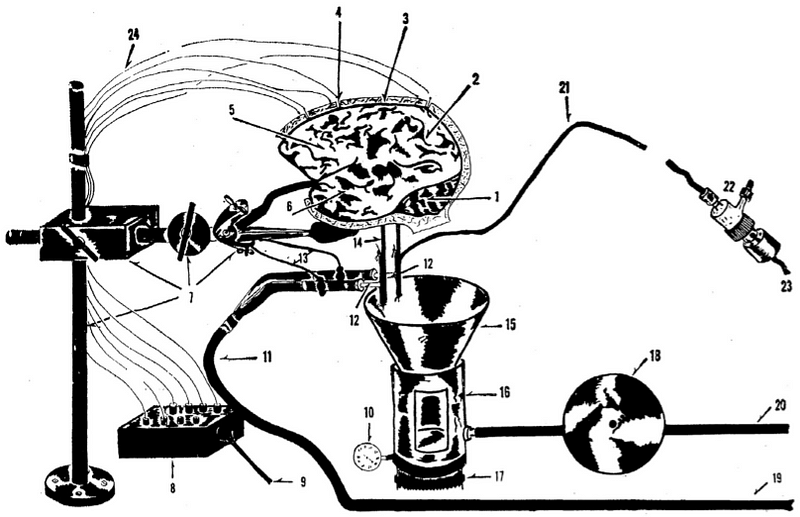
- cerebellum
2. occipital lobe
3. skull with electrode
4. cortical electrodes
5. the frontal lobe
6. temporal lobe
7. fixation unit
8. EEG plug-in-box
9. electrode cable connected EEG preamplifiers
10. venous reservoir thermistor
11. arterial line
12. carotid T cannulae
13. stirrup wire supporting arterial cannulae
14. internal carotid arteries
15. funnel for venous reservoir
16. venous reservoir
17. heater for the venous reservoir
18. occlusive venous pump
19. the arterial line from the femoral artery of the donor monkey
20. the venous line to the femoral vein of the donor monkey
21. arterial pressure line
22. pressure transducer
23. cable connected to the oscillographic recorder
24. EEG leads
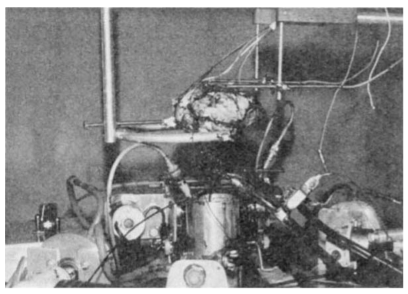
This system allows for keeping the brain intact until the transplant by offering enough blood and oxygen. In this way, the surgery team had enough time to properly sever the head from the monkey receive the donor’s head and make sure that during the process the spinal cord is not damaged. The whole process from a failed surgery to another trying to transplant the head from one monkey to another was a process of learning from mistakes and trying to perfect the surgery until reaching success.
Beyond the Impossible
In 1971, a neurosurgeon who has performed over 10,000 successful brain surgeries managed to perform the first successful head transplant (of a monkey). The first wonder was if the monkey maintains its sense and if it responded to sounds, touch, pain, and so on and so forth. From the tests done right after the surgery, the monkey kept all of its senses intact whilst not ending up paralyzed (as happened in previous tries of the same surgery).
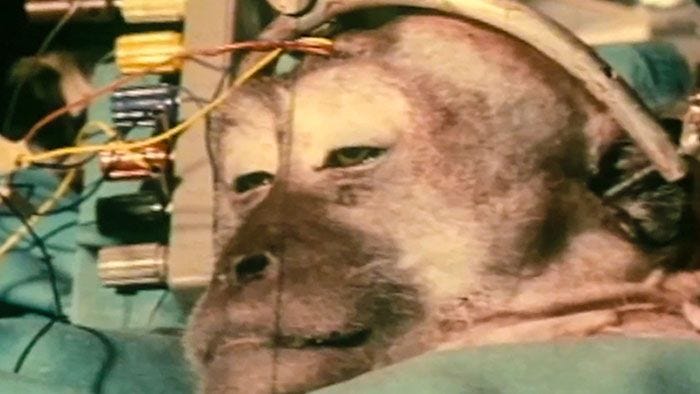
Even if for the time being the surgery was a success, the monkey did end up dying the next day from complications arising. White expected a hero’s reception for his efforts but was surprised to find that the public at large was appalled by his experiment. They saw him as a Frankenstein, a cruel vivisectionist, a mad scientist. Not to be deterred, White told his opponents that it is completely unacceptable to impose limits on scientific inquiry. His thoughts had turned elsewhere. From the instant the monkey had opened its eyes, White’s beliefs had, for him, been confirmed: it was possible to perform this operation on a human.
Another very interesting fact was that Doctor White tested to see if the monkey kept its consciousness. Before the surgery, the monkey was given a set of tasks from which she or he would remember certain objects or gestures so that she would be shown the same objects or gestures after the surgery and if she or he would recognize them that meant that the monkey kept its consciousness. The theory, however, is deemed invalid by many scientists as we still do not know with exactitude what consciousness is or how we can measure it.
Avid Writer with invaluable knowledge of Humanity!
Upcoming historian with over 30 million views online.
“You make your own life.”

